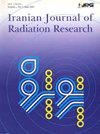Positron emission tomography-computed tomography guided radiotheraphy planning in lung cancer
Q4 Health Professions
引用次数: 1
Abstract
Aims and background: In three dimensional conformal radiotherapy (3DCRT), treatment planning is based on computerized tomography (CT) images. However, the data obtained from CT may not be sufficient in target delination. The purpose of this study is to show the differences between the radiotherapy (RT) plans which were done with positron emission tomography (PET) fusion or not. Methods: Patients with lung cancer between February 2009 and January 2012 at our institution were assessed retrospectively. Sixty patients who were treated with 3DCRT, CT simulation images were registrated with PET images. For each patient target volumes were determined and normal tissues were revised. Wilcoxon Signed Rank Test was used to compare the two groups. Results: For gross tumor volume (GTV), clinical target volume (CTV) and planning target volume (PTV); median volume values, median mean dose values and median maximum dose values were significantly different according to use of PET. About normal tissue doses; mean lung dose (MLD), lung V20, mean and maximum esophagus dose, V50 and V60, mean heart dose and maximum medulla spinalis dose were analyzed. Conclusion: Within these parameters there were statistically significant difference except in maximum dose of esophagus and V60. In our study, we observed decreased target volumes and higher dose distrubutions for target volumes in PET registrated RT plans. According to these data, it is possible to say that optimal RT plans can be formed for lung cancer by using PET registration.癌症正电子发射断层扫描计算机断层扫描引导的放射治疗计划
目的和背景:在三维适形放射治疗(3DCRT)中,治疗计划是基于计算机断层扫描(CT)图像的。然而,从CT获得的数据在目标脱钩方面可能不够。本研究的目的是显示是否使用正电子发射断层扫描(PET)融合进行放疗(RT)计划之间的差异。方法:对我院2009年2月至2012年1月收治的癌症患者进行回顾性分析。对60例接受3DCRT、CT模拟图像治疗的患者进行PET图像配准。确定每个患者的目标体积,并修正正常组织。采用Wilcoxon符号秩检验对两组进行比较。结果:肿瘤总体积(GTV)、临床目标体积(CTV)和计划目标体积(PTV);中位体积值、中位平均剂量值和中位最大剂量值根据PET的使用而显著不同。关于正常组织剂量;分析肺平均剂量(MLD)、肺V20、食道平均和最大剂量、V50和V60、心脏平均剂量和髓质最大剂量。结论:在这些参数范围内,除了食管最大剂量和V60外,其他参数差异有统计学意义。在我们的研究中,我们观察到在PET注册的RT计划中,靶体积减少,靶体积的剂量分布更高。根据这些数据,可以说,通过使用PET注册,可以形成针对肺癌癌症的最佳RT计划。
本文章由计算机程序翻译,如有差异,请以英文原文为准。
求助全文
约1分钟内获得全文
求助全文
来源期刊

Iranian Journal of Radiation Research
RADIOLOGY, NUCLEAR MEDICINE & MEDICAL IMAGING-
CiteScore
0.67
自引率
0.00%
发文量
0
审稿时长
>12 weeks
期刊介绍:
Iranian Journal of Radiation Research (IJRR) publishes original scientific research and clinical investigations related to radiation oncology, radiation biology, and Medical and health physics. The clinical studies submitted for publication include experimental studies of combined modality treatment, especially chemoradiotherapy approaches, and relevant innovations in hyperthermia, brachytherapy, high LET irradiation, nuclear medicine, dosimetry, tumor imaging, radiation treatment planning, radiosensitizers, and radioprotectors. All manuscripts must pass stringent peer-review and only papers that are rated of high scientific quality are accepted.
 求助内容:
求助内容: 应助结果提醒方式:
应助结果提醒方式:


